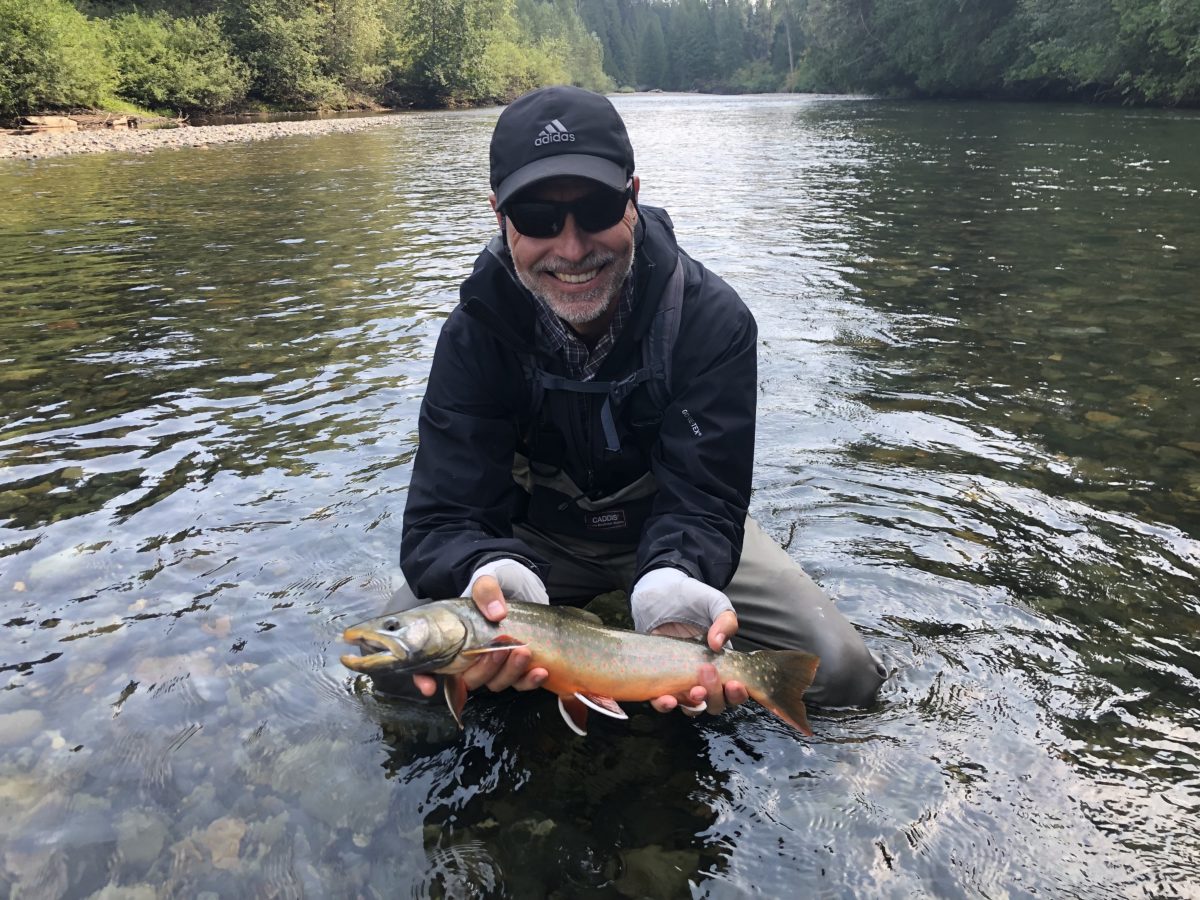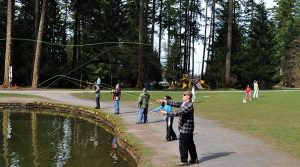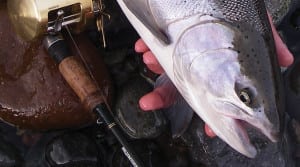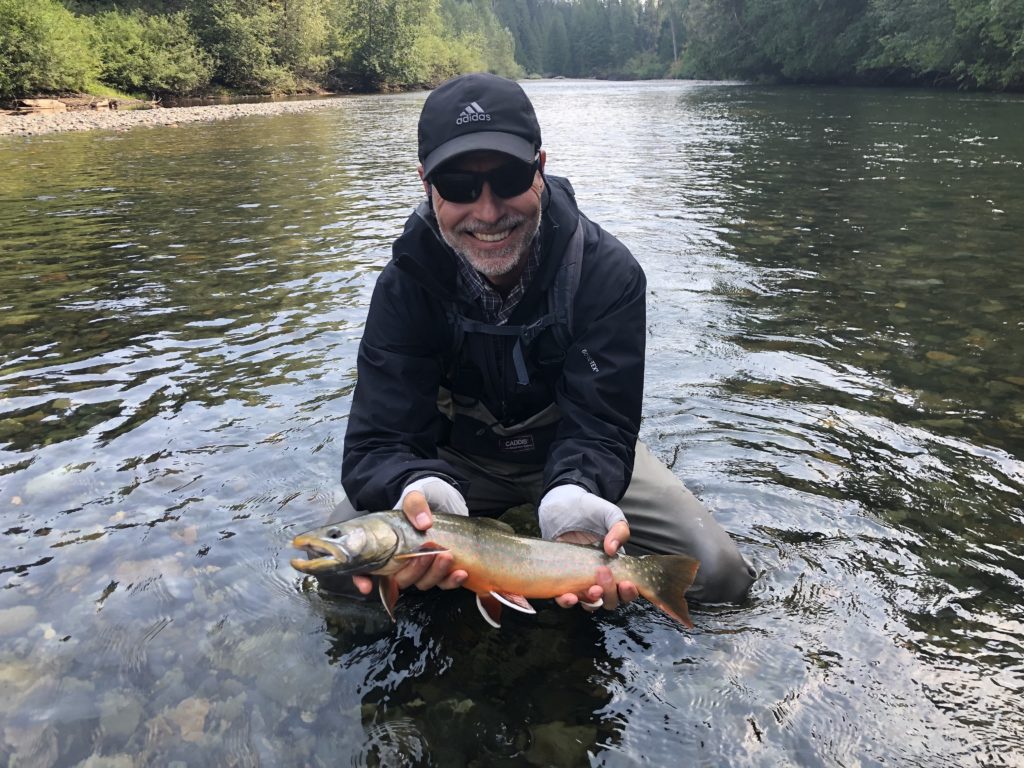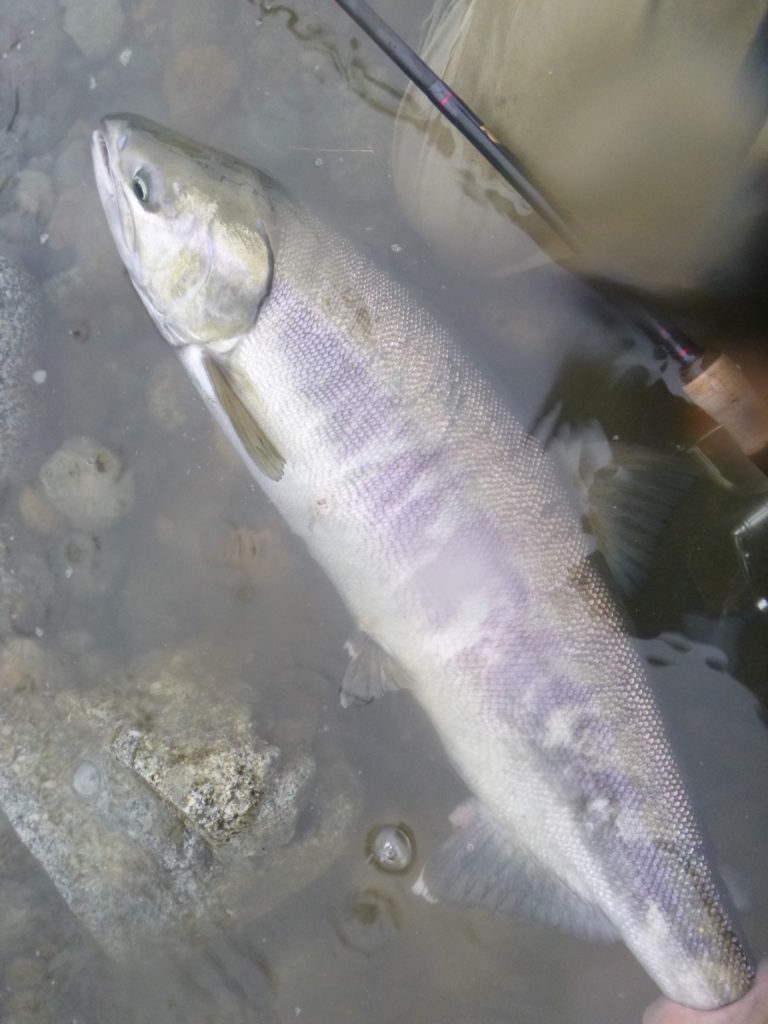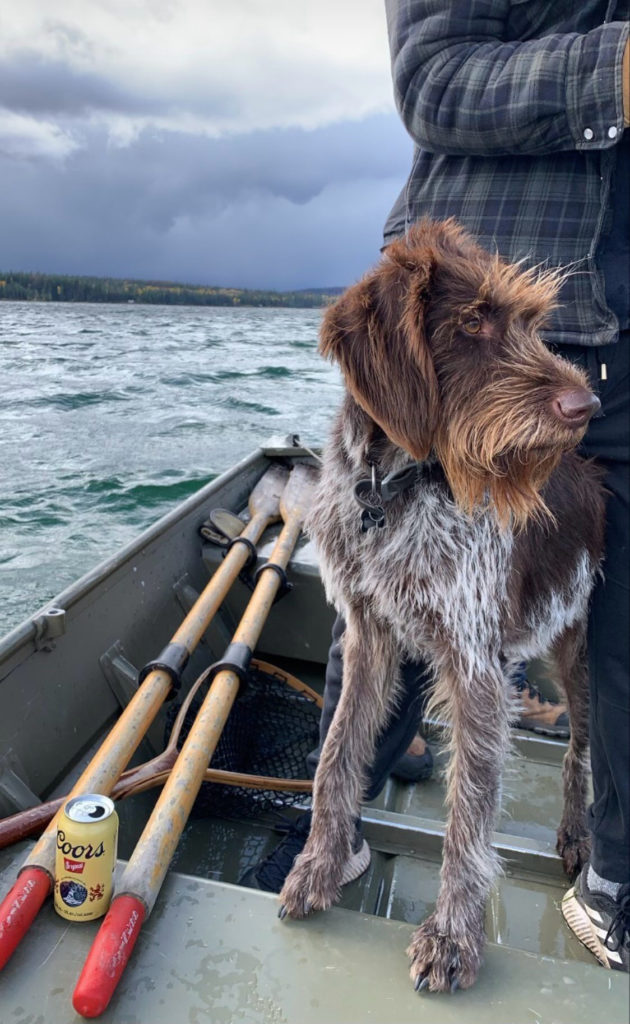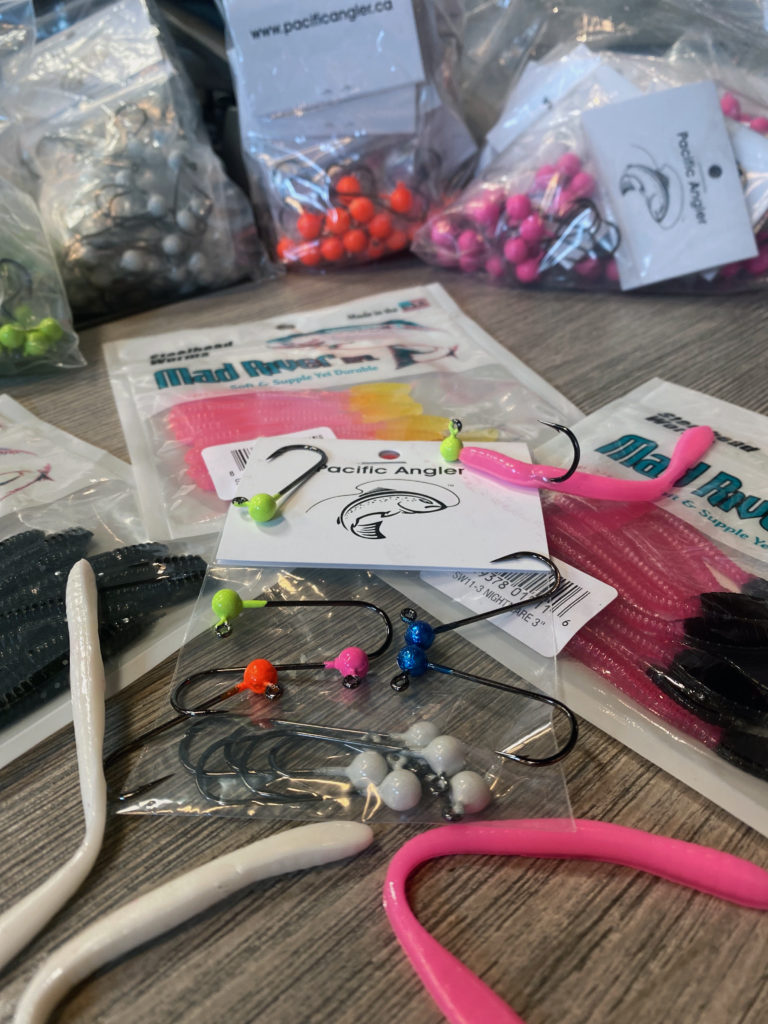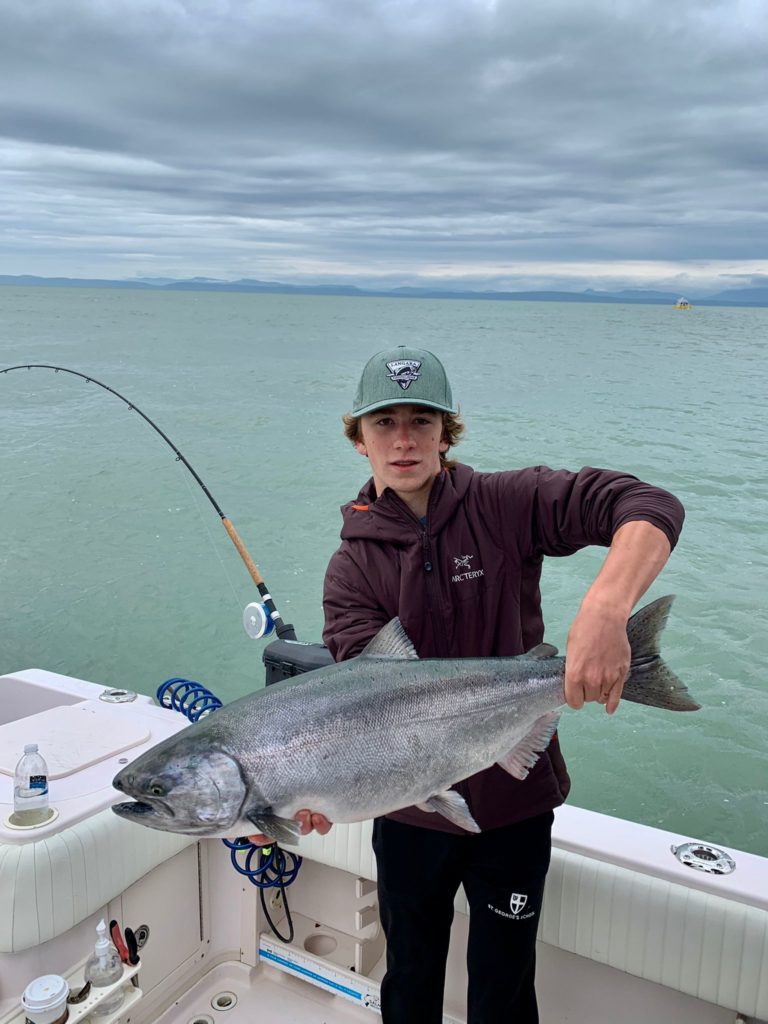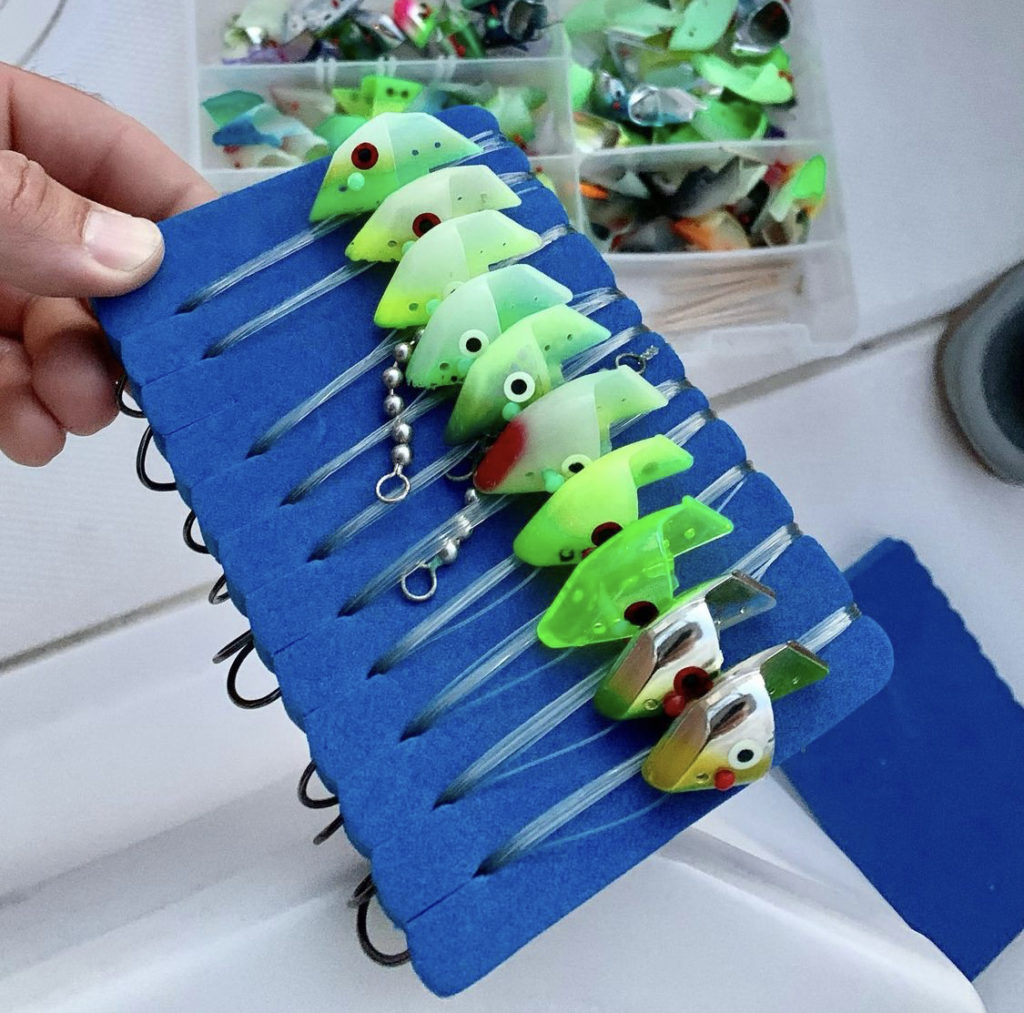OUTLOOK
It’s almost September – where has the summer gone? September is one of the best months to be an angler in the Lower Mainland. There are tons of options to get out on the water and the reports this week have been good.
In this week’s report, we have an overview of some of the major fisheries so you can start planning your fall adventures.
This week, we look at the Vedder and Harrison and we also tune in with Sterling and Matt for an interior lake overview as well as a fall trout fishing, report as both of these fisheries are great in the fall.
Jordan has a feature on our new jigs we just got in stock!
For those of you eagerly waiting for the anticipated openings on the saltwater planned for September 1, Jason has a detailed chinook report to get you prepared!
Matt’s back this week with another video version of the Friday Fishing Report. He was planning on keeping to his usual schedule which would have had him off this week, but things are moving fast right now in the fishing community and he wanted to get a video report out. In this week’s video, he goes over all the fisheries, talks about pink numbers, and touches on some issues with steelhead. He also has info on a net that was found on the Skagit; if you happened to have lost yours be sure to have a watch of the video!
See the video version of the report:
On to the Report!
CLASSES AND COURSES
Kids are heading back to school so why not join them? Now is a great time to brush up on some skills or learn something new
Introduction to Fly Fishing
This course is specifically designed to give the new fly fisher the basic knowledge, casting skills and fly fishing strategies to effectively fish our local BC waters. The course is comprised of two sessions; a 3hr evening Zoom seminar and a 3hr casting session. The dates below show the seminar date first and casting date second.
Seminar Date: September 21 Casting Date September 26
Cost: $150.00+GST
Seminar Time: Zoom Seminar 6:30pm – 9:30pm
Casting Time(s): 10am – 1pm or 1:30pm – 4:30pm
FALL SALMON RIVER FISHING: FLOATS, SPINNERS & SPOONS
This 3hr evening seminar covers float fishing, spinner fishing and spoon fishing; the three most productive techniques to catch BC salmon in a river. Upgrade your seminar to include a fully guided day on the water, putting into practice your new knowledge with a Pacific Angler guide.
Seminar: Sep 27, 2021
Guided Portion: SOLD OUT
Seminar Only Cost: $50.00+GST
Zoom Seminar Time: 6:30pm – 9:30pm
FRESHWATER FISHING REPORTS
Squamish River Fishing Report
Well things have cleared up a bit and good numbers of pinks are pushing through. Last night, the Mamquam did bump up a bit and added some colour but, this is good to get fish moving. Even if the river was coloured it was getting low, and the water will help move fish in. From the reports this morning the colour has not gotten too bad.
We have also heard of less anglers snagging fish. Again, if you read last week’s report, it is the angler’s responsibility to change gear or spots if your spot is producing snagged fish.
Guys and girls are running chartreuse and pink spoons, pink jigs and medium sized flies in the same color combinations and having success with these.
We are also hearing good bulltrout and rainbow reports coming from anglers breaking out the egg rigs further up river. In these areas you cannot target pinks, but the trout fishing has been good.
Remember that the pinks, bulltrout, and rainbows are all catch and release and the entire system has a barbless single hook regulation
Good Luck!
Matt Sharp
Skagit River Fall Trout Fishing Overview
The fall is debatably one of the best times to get out trout fishing. While everyone is thinking salmon fishing the evening temperatures are dropping and this means the bugs wake up and so do the hungry trout.
If you get out, look for days that have cool evenings but warm midday temperatures. When you get this, you will see mid-day hatches. On these days having a mix of small dark grey, olive or even yellow dry flies in the kit is smart. You can also look out for the large mayflies to start coming off and if nothing is working a size 10 even 8 gray/green mayfly imitation is one of my go-to patterns.
Bulltrout fishing will slow down in this time of year as the fish focus on spawning.
This river will close on October 31st and in season is always a single barbless catch and release fishery.
Good Karma Update – A customer/viewer found a net on the Skagit and wants to get it back to its rightful owner. If you lost a net on the Skagit, email Matt at Matt@pacificangler.ca . Hats off to Sean for spreading the good fishing karma and trying to get the net back to its rightful owner!
Matt Sharp
Harrison Salmon Fishing Overview
It’s almost September now, so that means fall salmon season is right around the corner for the Harrison River. The pinks should start rolling in early September, with the peak of the run arriving in mid-September-early October. Of course, there’s a huge amount of uncertainty with this year’s pink return, so it remains to be seen if there will be any openings, or if the fishing will be as good as it’s been in the past. The coho and chinook will also start to show up in early September, with coho runs carrying on all the way into late December and chinook trickling in until late November-early December.
The Harrison is a relatively large, fairly slow-moving river with somewhat limited shore access. As such, having some form of boat is an asset, as it allows access to some of the more productive areas. Having said that, shore-bound anglers still have a fair amount of accessible and productive water, mostly in the Kilby area.
Gear anglers will want to focus on casting spoons, spinners, and twitching jigs, but float fishing with jigs and bait can also be productive in certain circumstances. Fly fishing can also be very productive in the slow current and the clear water for which this river is well known; just adjust your gear based on the species you want to target.
If you’ve got a boat, the above options will obviously work well, and you’ll have the benefit of mobility. Of course, you’ll also have the option of anchoring and bar fishing or pulling plugs if actively chasing fish isn’t your thing and you’d prefer to sit back and relax.
The Harrison is tidally influenced, so timing your trips with the tides can be beneficial- I prefer an outgoing tide, but incoming tides can be productive as well. Be aware that wind can be an issue for both shore-based anglers and boaters- The Harrison can be notoriously windy, which makes for less than enjoyable conditions for boaters and bank anglers alike… just ask Andre about trying to fly cast on a windy Harrison day.
Taylor Nakatani
Chilliwack/Vedder River Fall Salmon Fishing River Report
Summer is almost over. It’s a sad thought but all good things have to come to an end. However, the fun doesn’t have to stop when it comes to fishing! Our fall salmon fisheries kick off in September and one of the most popular rivers that gets going first is the Chilliwack. Over the next couple of months this river will see coho, chinook, chum, pink, and sockeye salmon in the river. Yes, that’s right, that is all five Pacific Salmon and there will be open fisheries for at least three of those namely, coho, chinook, and chum. I am going to touch briefly on each species and how they relate to the Chilliwack River.
The run that will get the Chilliwack River Fall fishery going is the chinook salmon. Easily the largest of the salmon species, the Fall Chilliwack chinook typically range from 10-15lbs but it is not uncommon for fish to reach upwards 30lbs. The majority of these fish will be white chinooks though a few marbled fish are mixed in as well. They favour faster, deeper sections of the river and have the holding power to stay in these spots. Since these fish are large on average, we will want to use heavy tackle to target them. Medium-heavy to heavy powered gear rods and 9/10 weight fly rods or 8 weight spey coupled with 15-20lb fluorocarbon leaders are the norm. Chinook are typically not that picky and tend to be on the more aggressive side but popular methods of targeting them are drifting roe, beads, colorado blades, or jigs and casting big spoons/spinners and twitching jigs. Fly fishing with large streamers in some combination of black, blue, orange, chartreuse, and purple on a heavy sink tip can also be effective in the right spot. We typically start seeing Chinooks in the first week of September with a fair abundance by September 15.
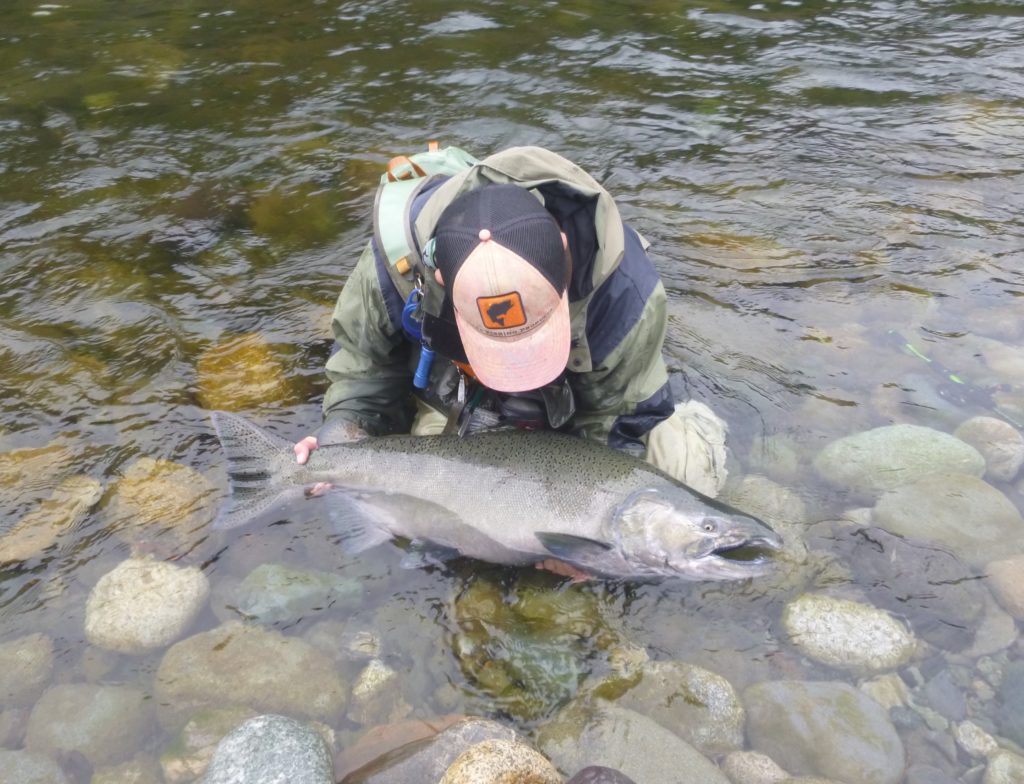
The next and most popular species to target is the coho salmon. Coho are sought after as a sport fish due to their feisty nature when hooked and are also known for their fantastic table-fare. Much smaller than the chinook, coho average 2-5lbs though there are both jacks, typically 1lb or less, and Northerns (over 10lbs) that do exist. Lighter tackle can be used for coho. Light to medium powered gear rods and 7-8 weight fly rods are ideal. They like to travel along the river edges and stack in stagnant or slow moving pools. While chinook are present in the river you may notice that the coho are relegated to tail outs or secondary holding positions as the chinook tend to push them around. Similar presentations can be used for both coho and chinook but the main difference is the type of water you will fishing and that usually dictates which species you will find. Fly anglers can downsize quite a bit and use patterns such as wooly buggers and Christmas trees. Coho start arriving around the same time as the chinook do but the run peaks later in October.
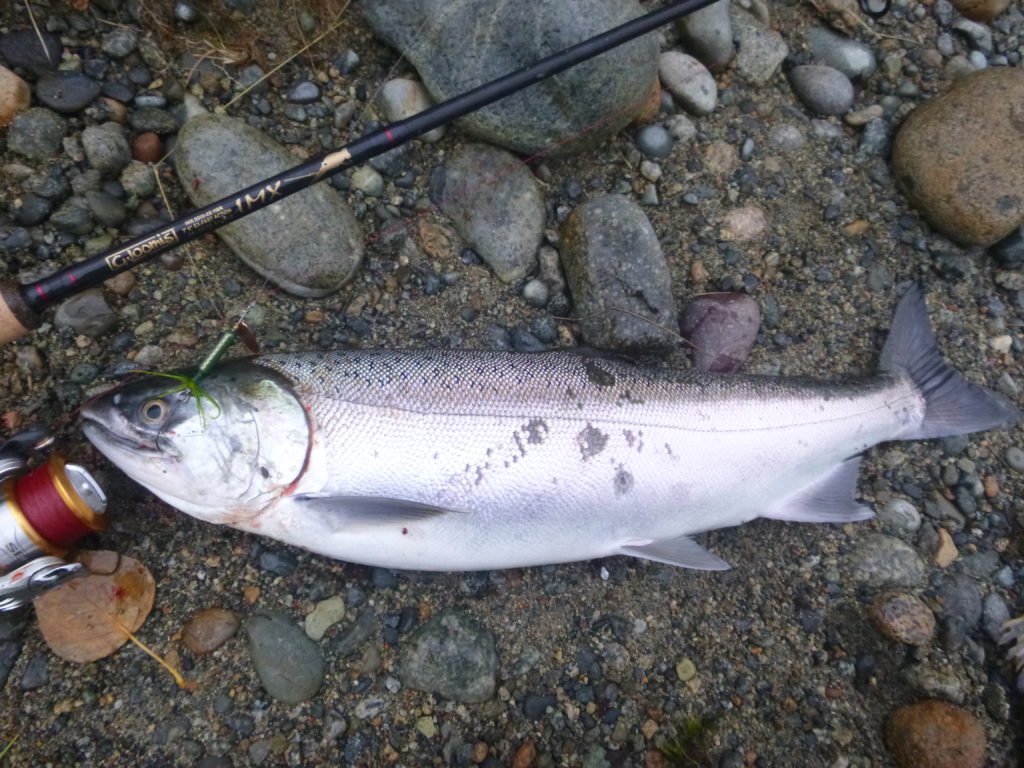
The third fishery that is a lot of fun on the Chilliwack is the chum salmon. This run gets going a little later as they aren’t really in the river in good numbers until October although they can be caught in the lower river by third week of September. Chum can be highly aggressive and for some reason love jigs and flies. As such, these fish make a fantastic intro fishery for new anglers. They will usually bite readily throughout the day as well so it isn’t necessary to get out there for first light. Chum are on the larger side and while not quite as large as chinook, they do pull quite hard and as such we recommend running similar gear.
Every odd-numbered year the Chilliwack also gets a return of pink salmon. As of me writing this on the 26th of August we currently do not have an opening for pinks, not even for catch and release. As such, I will not touch on this species at all really for this report as we are not allowed to target them yet. Be aware though that they will be in the river now and numbers will build throughout September. Keep an eye on the regulations as the pinks may have an in-season opening.
The fifth species, the sockeye salmon, will be in the river but is completely closed for fishing. Most sockeye you will encounter from now until November will be Cultus Lake Sockeye and are marked with an adipose clip. Please release these fish carefully as they are endangered.
This is a brief rundown on the fall salmon opportunities coming up on the Vedder. The time to start thinking about it and getting geared up is NOW. Gear will be in short supply this season so come down and get what you need before it is too late.
Alex Au-Yeung
STILLWATER FISHING REPORTS
Interior Lake Fishing Report
It’s finally time to talk about my favourite time of the year when it comes to lake fishing. It’s fall baby. Nothing beats waking up in the morning and seeing that heavy set fog sitting over the lake as the cold air meets the warm water.
Fishing lakes in the fall is extremely underrated as it typically results in some of the biggest fish that a lake can offer. Gone are the days of wondering if your chironomid is actually 1 or 2 feet higher or shorter than you set it at. Fall is the time when a large number of fish, including the largest, will push up onto the shallower shoals (<15ft) feeding on whatever happens to still be around. It becomes more of a hunt as you search bay after bay trying to find the water and feed that’s just right for the rainbows. Jumping or surfacing fish will always be the best indicator of fish sign so follow the fish if you have no idea where to start. This means following fish into 3 feet of water if need be. We fisherman are really good at being over analytical sometimes and it can sometimes pay off huge to try out something different than the norm. One of my most memorable fall days was the time I ended up casting into extremely weedy shallows because I saw one fish rise. Convention told me that there would be no way that more than one fish would be in those shallows. Turns out that there were hours of entertainment hidden there that I would’ve never had a chance to explore if I stuck to what was normal.
The shallow conditions means that fish can be extremely willing to feast on a platter of different food items including scuds, leeches, dragons, and boatman/backswimmers. I’m going to refer to boatman and backswimmers interchangeably in this article as they’re nearly the same bug.
Scuds and leeches are best fished either under an indicator on a floating line or with an intermediate sinking line. I find that fish will move a long way for the right presentation so don’t fret that your indicator is pegged 1 foot higher or lower than you thought it was pegged at. I always stick to the rule that 3 ft off the bottom is always a safe bet, especially when it comes to leeches. If you’re in 15 ft, set the indicator at 12 feet as the fish will actively come up in the water column to check out a well presented leech. Presentation does 80% of the work while colour does the other 20% to seal the deal. There have been many times where I have got fish to actively go out of their way to only reject my pattern in the end due to colour. One simple change like changing the colour or varying the stripping speed can lead to a different story completely. Apply the same logic to using an intermediate sinking line with more emphasis on changing the stripping speed. Everyone seems to have an opinion on this, but I’ve always had the most success with two short 2 inch pulls followed by a 2 second pause. I recognize that the retrieve is a little arbitrary when the fishing is really hot but sometimes it’s the little things that warrant change. Basically, what I’m saying is try that technique out and see if it works for the lakes you choose to fish. Different fish in different lakes will want different things but I’ve found that technique to be the most consistent.
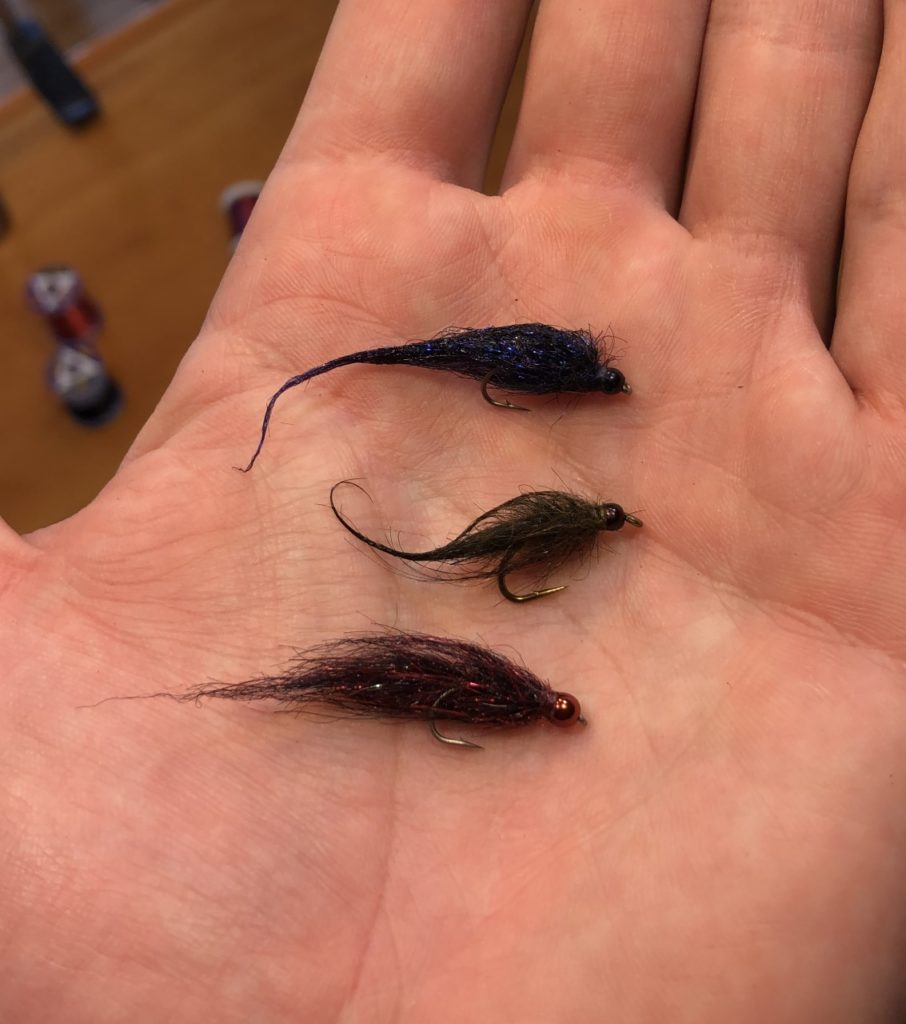
Dragons and boatmen/backswimmers are fished best on full sink lines. I’ve written quite extensively on how to fish dragonfly patterns but ultimately a heavy sinking line with a 3-5 ft section of leader and a floating body fly i.e. deer hair or foam body is the best way to go. For boatmen, it’s a bit more technical as you sort of need to match your fly line to your fly pattern. Boatmen are tied a various number of ways as they both surface and dive back deep. Flies are often tied in a manner to either mimic this emergence or descent. For foam body ties, I like to fish them on a full heavy sink to really allow the line to sink. For bead head bodies, I prefer to use a floating line with an integrated type III or V sink tip. In either case, you’re going to be using a rapid, jittery retrieval to mimic the motion of a boatman moving through the water column.
Best of luck out there!
Sterling Balzer
JIG FEATURE
The past couple of seasons you may have noticed that we carry some very nice painted jig heads in both tungsten and lead, from two different suppliers, that many of you have been using to tie up float and twitching jigs. Well, we’ve finally been able to source and produce the same great colours of our painted lead jigs that you’ve loved in the past but now in a 3/16th size!
A lot of float anglers, myself included, like fishing relatively light jig heads when fishing worm-jigs for salmon and steelhead, as well as trout and char. I’ve noticed that the lighter heads on a 2/0 VMC hook, help get the worms down into the zone, but don’t hang them there static and still under your float. By using the lighter heads with the same amount of hook weight the worms are able to get down but still dance and move lively.
I like to generally pair a hot or brightly coloured head with a darker worm, and vice-versa with the bright worms and dark heads. That being said, having a variety of them in various colours and weights is key as different water slots, troughs, and lanes may require different approaches.
I’m not really sure how much it affects the worms action, but I also like to keep the majority of the balancing weight right under my float, with the rest down by the swivel, and then none down the leader. I feel this helps balance the float and keep it tracking true, while the line and leader underneath it is, in a sense, free to move around lively.
Come on into the shop to see the variety of jig heads we carry, along with all of our other great float-fishing offerings!
Jordan Simpson
SALTWATER FISHING REPORTS
Special Chinook Report
With opening day of September 1st fast approaching, it’s time to talk chinook. Although the announcement hasn’t come out yet, the Integrated Fisheries Management Plan does show an expected opening as of September 1st, 2021, for 2 chinook a day, min size 62 cm, no max size, clipped or unclipped (hatchery or wild), in our local waters. So, in short, you can fish the Fraser mouth area again and keep chinook on the morning of September 1st.
The bulk of the red fleshed fish, aka red springs, has passed. Numbers usually peak later in the third week of August. There will still be some around on Sep 1 and there will be a few white fleshed chinook, aka white springs in the mix. The white spring numbers will increase and eventually peak late in the second week of September.
All these chinook travel fairly shallow in the water column, primarily because they aren’t actively feeding on the bait balls, usually close to bottom and are actually up in the area of fresh or brackish water, trying to find their way into either the North Arm of the Fraser or the South Arm of the Fraser and eventually their natal river. Most of the reds are heading up to the Thompson or other rivers further afield, and all of the whites are going to 1 of 3 rivers. The Capilano, the Vedder/Chilliwack, or the Harrison. Both the Cap and Vedder fish are progeny of the Harrison River white spring genetics.
Effective depths for both chinook species range from 20-80 feet on the rigger, but by far the majority of the fish are caught between 30 and 60 feet. A great way to cover all depths is with stacking, usually a 20-25 foot spread works great. If you aren’t stacking, try 35 and 45 in the morning and drop it down a bit later in the day around 45 and 55. A few days you can find fish deeper in the 60’s and 70’s, sometimes even as deep as 90, but again, most of these fish run shallow.
As with most salmon that are staging off river mouths, bait is a top producer. Anchovies or herring in teaser heads are the go-to for our area. I like Rhys Davis Anchovy Classics for anchovies or Rhys Davis Super Herring Teaser heads for larger herring like blues (medium). On my shallowest rod I like a chrome teaser head, usually chrome green/chartreuse. On my next rod down, I like UV Magna Green. From there I get into the glow finishes. My favorite ones incorporate glow, and you guessed it green and chartreuse. There a quite a few from Rhys Davis and Oki Tackle that fall into this category. Selection is limited right now due to demand and delays in the factory, so if you find some that have glow, green, and chartreuse in them, better grab them! We just got an order in, and we have some very good ones, like No Bananas and Chartreuse Glow Splatter for example, so get into the shop and get some before we run out.
Speaking about demand, bait is in short supply and high demand. Anchovies are pretty much gone for the most part, and some shops are charging as much as $20 a tray. We have some right now, but I don’t imagine they will last the weekend or even the end of today. We do have some smaller herring (reds) on the way, and they will fit into an anchovy teaser head quite nicely. We also have some medium herring (blues) in stock with more on the way. These work very well for chinook in a Super Herring Teaser head, which we have in stock in some great UV and glow finishes. Just a heads up, we aren’t holding bait, we just don’t have the room. So, if you want bait you will need to get to the shop, pay for it and take it with you. We can’t take phone orders, payment, and then hold the bait as we need that bait to move the very moment we sell it so we can bring more in from our cold storage.
When it comes to flashers, my choices pair up with the teaser heads. I like chrome versions on my shallowest rod with my favorite being a chrome Betsy or chrome Herring Aid or Super Herring Aid. Next rod down I like a UV Green/Chartreuse flasher like a Green Onion or Green Onion Glow, Yellow Green Kinetic Mist, Derby Winner, or something similar. On the deeper rods I like chartreuse and glow flashers like Glow Herring Aid, Salty Dawg, Lemon Lime, to name a few. Again, lots of demand and limited supply, so get what you can when you can. Luckily, we booked heavy, so we have stock on some of the top producers right now.
Do spoons and hootchies work? Yes, yes, they do, just not as good as bait on most days. When the fish are thick and the bite is on, you bet, they work, and you will get your fish. On the slower days when there are fewer fish around you will be glad you are rolling bait, it does make a difference. If you can’t get bait, or you run out of bait, fish spoons and hootchies but make sure you load them up with gel scent like Pro-Cure Gel Scent in Herring and Anchovy.
No Special Chinook Report would be complete without some politics and data. A lot of people are wondering why we are closed in August for chinook and if we will get it open again one of these days. Well, we are closed in August because there is a chance you might hook a chinook stock of concern. Most of these stocks of concern are long gone by August, they usually enter the river in April, May, June, and July. However, a few are around in August. How many you ask? Well in 386 samples taken in August and September, 6 of them were stocks of concern. Or in other words, you have 1.55% chance of hooking a stock of concern. In terms of how this shapes up to % of the expected return, you are looking at that being 0.39% of the expected return. Of those stocks of concern, most of them would have been from earlier in August because by September most of the red chinook are long gone in general, stock of concern or not.
Keep in mind a lot of these stocks of concern are larger than 80 cm and aren’t in the Fraser Mouth area in late August. That is why there was a proposal to DFO to open things up later, approximately August 15th, to protect the very few remaining stocks of concern. With this later opening, that 1.55% chance of encountering a stock of concern would be dramatically reduced. As an added conservation measure, a slot limit of 62-80 cm would protect the odd stock of concern encountered. Imagine how small the encounter rate would be if we had an August 15th opening and a slot limit of 62-80. A lot lower than 0.32% of the expected return, that is for certain.
Despite this, the proposal was not accepted by DFO. So much for science, social and economic impact, logic, and your right to sustainably harvest a chinook. Oh, one more thing, while all this is going on and the public is closed to protect those stocks as per the above information, the river is full of gill nets, legal and illegal.
Last year First Nations harvested about 25,000 chinook during legal gill net openings while the public was closed. The year before that it was around 40,000 chinook. This year I am not sure where the numbers will be, but in the tens of thousands for sure. To add insult to injury, over 212 illegal gill nets have been seized in the Fraser, one of the worst years ever. Last time I checked, gill nets didn’t select for 62-80cm size chinook, or endangered sockeye, summer steelhead, or juvenile sturgeon.
How DFO and this current federal government can micromanage the public fishery and then allow these in river fisheries and illegal fisheries is beyond me. I am not against food fisheries, but I believe there should be some opportunity for ALL Canadians, especially those that can fish a single barbless hook and select for fish in the 62-80 cm range, at one a day, 10 per year.
Those are the facts fellow public fishers, so remember that when you head to the polls this September. I am not going to tell you who to vote for, just that the Liberals are not interested in the public fishing sector and that they were the only political party NOT to sign off on fishing proposals specifically designed to offer public opportunity deemed low risk to stocks concern, while maintaining First Nations food fisheries. I will leave it up to you to decide where your X should go.
See you in the shop or on the water,
Jason Tonelli


